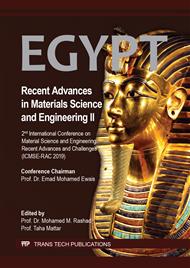[1]
V. Coman, B. Robotin, P. Ilea, Nickel recovery/removal from industrial wastes: A review, Resources, Conservation and Recycling, 73 (2013) 229-238.
DOI: 10.1016/j.resconrec.2013.01.019
Google Scholar
[2]
X. Maoquan, High temperature oxidation and wear behavior of powder metallurgically developed Ni-Cr-W-Al-Ti-MoS2 composite" Indian J Eng Mater Sci, 16 (2009) 111-115.
Google Scholar
[3]
L.Z. Mohamed, W.A. Ghanem, O.A. El Kady, M.M. Lotfy, H.A. Ahmed, F.A. Elrefaie, Oxidation characteristics of porous-nickel prepared by powder metallurgy and cast-nickel at 1273 K in air for total oxidation time of 100 h, J Adv. Res.(JAR), 8 (2017) 717–729.
DOI: 10.1016/j.jare.2017.08.004
Google Scholar
[4]
L.Z. Mohamed, W.A. Ghanem, O.A. El Kady, M.M. Lotfy, H.A. Ahmed, F.A. Elrefaie, Oxidation characteristics of porous nickel low-chromium binary alloys in air at 1273K for 100 h, KEM, 786 (2018) 37-43.
DOI: 10.4028/www.scientific.net/kem.786.37
Google Scholar
[5]
C.H. Zhou, R.Y. Pan, H. Zhang, X.G. Guan, Oxidation behavior of Ni-10Cr alloy under the compressive stress at 900 ℃, 3rd Asia-Pacific Electronics and Electrical Eng. Conf. (EEEC 2018), (2018).
DOI: 10.12783/dtetr/eeec2018/26886
Google Scholar
[6]
L.Z. Mohamed, W.A. Ghanem, O.A. El Kady, M.M. Lotfy, H.A. Ahmed, F.A. Elrefaie, Oxidation characteristics of porous Ni-12 wt%Cr alloy at 1000 ℃ in air, Ain Shams Eng. J., 9 (2018) 2993–3000.
DOI: 10.1016/j.asej.2018.02.001
Google Scholar
[7]
C. Quan, S. Deng, Y. Jiang, C. Jiang, M. Shuai, Characteristics and high temperature oxidation behavior of Ni-Cr-Y2O3 nanocomposite coating prepared by cathode plasma electrolytic deposition, J. Alloy Compd., 793 (2019) 170-178.
DOI: 10.1016/j.jallcom.2019.04.063
Google Scholar
[8]
K. Narinder, K. Manoj, S.K. Sharmaa, D.Y. Kima, S. Kumarc, N.M. Chavanc, S.V. Joshic, S. Narinder, S. Harpreet, Study of mechanical properties and high temperature oxidation behavior of a novel cold-spray Ni-20Cr coating on boiler steels, Appl Surf Sci., 328 (2015) 13-25.
DOI: 10.1016/j.apsusc.2014.12.033
Google Scholar
[9]
K. Ercan, K. Mustafa, Effect of microstructural evolution and elevated temperature on the mechanical properties of Ni–Cr–Mo alloys, J Alloy Compd., 619 (2015) 82–90.
DOI: 10.1016/j.jallcom.2014.09.036
Google Scholar
[10]
T. Benoît, A. Catherine, N. Bernard, Electronic and transport properties of passive films grown on different Ni-Cr binary alloys in relation to the pitting susceptibility, Electrochim Acta, 133 (2014) 373-381.
DOI: 10.1016/j.electacta.2014.04.067
Google Scholar
[11]
L. Chaman, S. Eric, High nickel alloys offering a combination of high strength and high impact properties, Powder Metall Conf. (2013).
Google Scholar
[12]
B.J. Babalola, M.B. Shongwe, B.A. Obadele, P.A. Olubambi, Densification, microstructure and mechanical properties of spark plasma sintered Ni-17%Cr binary alloys, The Int. J Adv. Manufacturing Tech., 101 (2019) 1573–1581.
DOI: 10.1007/s00170-018-3062-y
Google Scholar
[13]
E.H. Kottcamp, et.al, ASM handbook, 3 (1992) 692.
Google Scholar
[14]
Y. Ustinovshikov, Phase transformations in alloys of the Ni–Cr system, J Alloy Compd, 543 (2012) 227–232.
DOI: 10.1016/j.jallcom.2012.05.120
Google Scholar
[15]
P. Nash, The Cr-Ni (chromium-nickel) system, Bull Alloy Phase Diagr, 7(5) (1986) 455-476.
Google Scholar
[16]
K.S. Chan, P. Yi-ming, L. Yi-der, Computation of Ni-Cr phase diagram via a combined first-principles quantum mechanical and CALPHAD approach, Metall Mater Trans A, 37A (2006) (2039).
DOI: 10.1007/bf02586124
Google Scholar
[17]
P.W. Lee, et.al, ASM Handbook, 7 (1998) 915, 1052.
Google Scholar
[18]
M.M. Mohammed, O.A. Elkady, A.W. Abdelhameed, Effect of alumina particles addition on physico-mechanical properties of AL-matrix composites, O J Metal, 3 (2013) 72-79.
DOI: 10.4236/ojmetal.2013.34011
Google Scholar
[19]
J.C. Lippold, S.D. kiser, Welding metallurgy and weldability of nickel-base alloys, (2009) 420.
DOI: 10.1002/9780470500262
Google Scholar
[20]
P. Bayliss, D.C. Erd, M.E. Mrose, A.P. Sabina, D.K. Smith, Mineral powder diffraction file- data book, (1986) 227,830.
Google Scholar
[21]
H.E. Swanson, E. Tatge, Standard X-ray diffraction powder patterns, Natl. Bur. Stand. (US) Circ, 539(1) (1953) 13.
Google Scholar
[22]
Swanson et al, Standard X-ray diffraction powder patterns, Natl. Bur. Stand. (US) Circ, (1955) 539- 20.
Google Scholar
[23]
O. Bergman, Key aspects of sintering powder metallurgy steel prealloyed with chromium and manganese. PhD, Gothenburg, Sweden, (2011).
Google Scholar
[24]
B.W. Roberts, R.A. Swalin, Concerning an order-disorder transition in the Ni-Cr system, Trans Am Inst Min Metall Pet Eng, 209 (1957) 209- 845.
DOI: 10.1007/bf03397927
Google Scholar
[25]
R.W. Heckel, M. Balasubramaniam, The effects of heat treatment and deformation on the homogenization of compacts of blended powders, Metall Trans, 2 (1971) 379-391.
DOI: 10.1007/bf02663325
Google Scholar
[26]
C. Tien-Fu, G.P. Tiwari, I. Yoshiaki, Y. Kiyoshi, Volume and grain boundary diffusion of chromium in Ni-base Ni–Cr–Fe alloys, Mater Trans, 44(1) (2003) 40-46.
DOI: 10.2320/matertrans.44.40
Google Scholar
[27]
W. Qiong, L. Shu-Suo, M. Yue, G. Sheng-Kai, First principles calculations of alloying element diffusion coefficients in Ni using the five-frequency model, Chin Phys B, 21(10) (2012) (109102-1) -(109102-7).
DOI: 10.1088/1674-1056/21/10/109102
Google Scholar
[28]
G.F. Vander. et.al, ASM handbook, 9 (2004)1987-1991.
Google Scholar
[29]
C.S. Pande, B.B. Rath, M.A. Imam, Effect of annealing twins on Hall-Petch relation in polycrystalline materials, Mater Sci Eng A, 367 (2004) 171-175.
DOI: 10.1016/j.msea.2003.09.100
Google Scholar
[30]
F.J. Humphreys, M. Hatherly, Recrystallization and related annealing phenomena. Second Ed, (2004) 292-313.
Google Scholar


